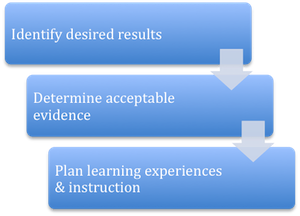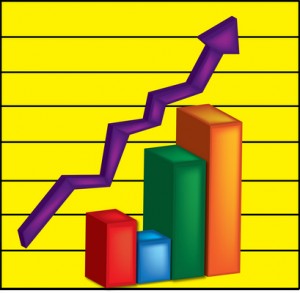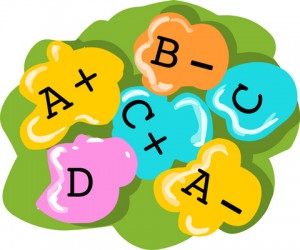How Better Grading Reshaped My Teaching
A MiddleWeb Blog
 By Shara Peters and Rebecca Berger
By Shara Peters and Rebecca Berger
Recently I gave my 8th grade U.S. History students a pop quiz about documents that influenced the Constitution. Afterward, an overjoyed student came running up to exclaim, “Ms. Peters! I UNDERSTOOD everything this time!”
This particular student had struggled earlier in the year and had been seeing me regularly to revise previously submitted work and to retake previously failed tests.
What stood out to me about her exclamation was not that she was excited that she did well – most eighth graders would be excited about doing well on a quiz. Rather, this student chose to say that she “understood” the material, not that she “got an A.”
For me, this moment confirmed that the grading policy at my new middle school can alter the way students and teachers approach teaching and learning.
A New Take on Grading
As I started in my new position, I was very skeptical about the school’s approach to grading. A few features of their policy stood out to me as red flags: no homework, group work, or student participation can be graded.
My initial reaction was that of concern – how can we be preparing students to be successful in the increasingly collaborative “21st century world” if we are unable to assess group work?
My approach to teaching includes a lot of project-based learning, where collaboration is paramount. What about that? And on a more basic level, how can I ensure that my students will do their homework?
But…my students do their homework. Mostly. And the ones who don’t probably would have incomplete homework even if it were graded. I am still able to have a class built around collaboration, but instead of giving one grade to a group for a project, I grade the written reflections individually produced by the students after the project has been completed. This has helped ease many tensions that arise during group work.

New Grading Practices Are Transforming My Lesson Design
I have only been working within this framework for a few months. Already it has transformed the way I build my curricula. My students and I are significantly more focused on in-depth understanding and mastery of concepts as opposed to “the grade” in and of itself.
Alfie Kohn confirms the benefits of this mindset for students: “Students who are motivated by grades or other rewards typically don’t learn as well, think as deeply, care as much about what they’re doing, or choose to challenge themselves to the same extent as students who are not grade oriented” (Kohn, 1993).

Since my perspective on teaching has changed so drastically in such a short period of time, I wondered what kind of impact it could have on a teacher who has been using this method for a while. I sought out a colleague, Rebecca Berger, to discuss how our school’s grading policy has influenced her philosophy of grading in her seven years at the school.
What follows are our collective reflections. We hope that by explaining the rationale behind our assessment policy, we might prompt other educators to further consider their own grading practices.
Grades Should Reflect Learning, Not Completion

It was quite possible (and was often the case) that organized, responsible students might show B-level comprehension of content through assessments but would still earn an A in the class because their grade reflected their tendency to complete their work, not their understanding of the material.
By contrast, at our school, we only grade summative assessments.
All formative assessments are truly formative – they are used as tools for students to gauge their own learning and to inform teachers on the effectiveness of their teaching. In the past, students would complete classwork and homework because they were motivated by grades. Now, students complete classwork and homework because they know that teachers have purposely designed the activities to further their mastery of core concepts.
Final report card grades now accurately reflect what the student knows and can do; an A now represents A-level content mastery as opposed to A-level responsibility.
Improve and Reflect
Because we only grade summative assessments, one might think that this system could lead to higher test anxiety. However, another facet of our school’s grading policy is that all summative assessments are able to be retaken or revised if it is clear that the student did not understand the content.
For example, my Constitution test is divided into three main subjects: Articles of Confederation and why it failed, Articles I-III of the Constitution, and the Bill of Rights. If a student shows that they did not understand one of these content areas, they meet with me so I can reteach the material, and then they take a different mini-assessment on the same content.

If they missed the mark on supporting their statements with evidence, or did not provide sufficient analysis, or have factual inaccuracies in their writing, they can revise and resubmit. However, they cannot revise for writing mechanics: if a student did not take the time to proofread their work, or if their writing was not academic in nature, those points cannot be earned back through revision.
To keep the revision process from being endless, all students may only revise or reassess once for the missed learning target. If they demonstrate C-level understanding on their reassessment, that is the score that gets recorded in their final grade. This simultaneously causes students to relax (a little) on the initial assessment and to take the reassessment opportunity seriously.
As Ron Berger asserts, “students need to know from the onset that quality means rethinking, reworking, and polishing” (Berger, 1993).
Differentiated Assessment

We make sure that a test has varied forms of questions that assess a variety of levels of comprehension, from basic recall to analysis and synthesis. We also use alternative assessment techniques, including scored discussions, portfolios, and presentations.
Thanks to narrative report cards, we still have the ability to speak to students’ study skills, classroom behavior, participation, etc. We also can give suggestions for the future as to how they can improve. But because of the grading policy, we find ourselves using language like “fully demonstrated content mastery” as opposed to “earned 98%.” If a student is not succeeding in class, it is incumbent upon us to find specific language to name exactly which concepts and skills the student is not proficient in.
Growth Mindset
At this school, students do not resist revisiting their work as much as we had seen at prior schools. Here, students know that if they work hard enough and take the time to meet with us during Office Hours, then they can succeed. They see the direct link between their willingness to work hard and the end result.
This sometimes means that eighth graders who I might perceive as “C” students end up earning “A’s” because they keep working at learning the material until they have achieved mastery. Even though I am not giving extra assignments to pad grades, most students (who take advantage of revision opportunities) end up with A’s and B’s in my class.
Kohn argues that with this type of grading policy “helping students to improve becomes more important than evaluating them; learning takes precedence over sorting” (Kohn, 1993).
Nothing Is Perfect
This system has been quite successful for our setting (an independent middle school). Our students leave our school and go off to a variety of settings for high school: public, private, charter, academically rigorous, artistically enriched, and everything in between. In what ways is this grading approach preparing them – or not preparing them – for their future endeavors?

Fair question: Does our policy send students the right message about what they will need to be able to do in high school and in the working world?
When working in collaborative environments in the workplace, people are judged on the quality of the final product, not simply the segment that each individual contributed. In inequitable groupings, someone ends up pulling weight for other less productive team members.
Fair question: Is telling students that what ultimately matters is their own understanding and not the group product sending the right message about collaboration? Is it too individualistic, or is it developmentally appropriate at the middle school level?
What’s the Point?
In the end, it comes down to this essential question: “What is the point of grading students?” The answers may vary depending on the culture of your school, the values of your community, and your goals as an educator. Our grading system is driven by measuring student comprehension of content, building facility with skills, and encouraging growth mindset. What values does your grading system reveal about your educational setting? How does your grading system shape your practice?
Sources
Berger, R. (2003). Ethic of Excellence: Building a Culture of Craftsmanship with Students. Portsmouth: Heinemann.
Kohn, A. (1994, October). Educational Leadership: “Grading: The Issue Is Not How But Why.” Accessed Dec. 27, 2015.
Kohn, A. (1993). Punished by Rewards: The Trouble with Gold Stars, Incentive Plans, A’s, Praise and Other Bribes. Boston: Houghton Mifflin Company.
Rebecca Berger, Shara Peters’ colleague and co-author of this article, has been teaching middle school at an independent school for the past nine years. She earned her teaching credential and her M.A. at Hebrew Union College Jewish Institute of Religion.


































I think the point of learning is content mastery, period, and so the grading should reflect that, period. Consequently, I am in complete accordance with your school’s approach, and as both a credentialed, certified (in two states) elementary school teacher and longtime veteran of the real working world outside education, I think it prepares students well for life beyond school. While a team’s product is, of course, what matters in the workplace. A weak team member will be covered for only so long, and fellow team members will eventually out him/her to the superior if laziness or incompetence persists. My Catholic school did not count formative assessments, homework, etc., into the class grade on the report card. Effort, conduct, etc., were assessed separately from content mastery through 8th grade. I think it put the emphasis where it needed to be.
Thanks for your perspective, and good point about team work in the workplace.
I find the students who really need t revise work, seldom do. I and other colleagues have even had parents consider it harassment if we suggest a student revise work. Part of this is lack of systemic change…revision is individual teacher policy, not the school policy. Any suggestions?
I have definitely experienced that too — it’s the kids who get the B’s who are clamoring to revise whereas the kids who get the C’s or worse aren’t always the ones to take initiative when they need to. One strategy I sometimes use is that if a student earns a C or below (and I expect that student to revise) I make a note to myself of the student’s initial grade and write detailed comments on his/her paper, but don’t actually give the student a score. Instead, I write “See me about revisions.” And only once the student has revised his/her paper will I actually give the student a letter grade. To the student’s parents, I say that they have not met the standards of the assignment and will have an incomplete until they revise.
I really like the approach you suggest here for revisions (or in my students’ cases) re-quizzing. I may make a trial run with this concept this semester to get my below-basic and basic students to utilize the opportunity to revise/requiz for growth!
I’ve also had that experience at other schools where the concept of “revision” was more ambiguous, and I totally know what you mean when you say that some parents consider it harassment. What is really different here is the language you can use when talking with parents– the focus is not on the work, but on whether or not the student understood what you’re teaching. The revision isn’t just reworking previously submitted assignments for the assignment’s sake, it’s giving the students another chance to prove that they “get” the material. I’ve noticed that parents often get more defensive when talking about their child’s work than talking about their child’s understanding. It’s hard to argue with the statement, “Jill doesn’t understand geography of the Roman Empire, let’s help her fix that.”
Also, there is only one revision opportunity. Period. That helps cut down on the harassment aspect that could come from unclear amounts of revision opportunities. And if they don’t choose to take advantage of the revision opportunity, I always give their parents a heads-up email.
It would of course be easier if your whole school took this on, but it’s totally possible to do as your own classroom-specific policy. I would recommend clearly articulated guidelines that are posted on your class website, referred to often, and explained at back to school night. And most importantly, the solid backing of your administrator.
I love that your school has rethought grading, and I’m even happier that you wrote about it! I wonder how many students a policy like this could be effective with. At my last school, an independent and progressive Jewish elementary school, I was a part of recreating the grading policy, and Alfie Kohn’s work was paramount to our decision to disregard letter grades altogether. Now that I’m in a public middle school with about 100 students this semester, I couldn’t see most of my colleagues taking the time I take for revisions. Does anyone have experience with less traditional grading methods in public schools?
Altering the learning process from teacher-output-to-students to students imbibing the learning for themselves creates a environment in which students assume for themselves the role of active learner and set their own goals for advancement – my methods: metacognition.
I taught high school students (grades 9-12; ESL college prep, honors, and AP) English in a public school. I instructed my students on the value of their metacognizing about their own learning. Having students to metacognize about their processes and progress does enhance their cognition, their understanding about content, their purposes for learning, and does diminish their working for the grade and for the teacher (another huge difference).
Fair Question #1: yes it does. The policy you and your colleague, and now ultimately the school-at-large, is embarking on IS what the students are charged with navigating, and is what is preparing them for high school and work world settings. The fact that they are progressing and improving in this system is the key. Especially since they are engaged and showing excitement as you have described. The more systems and scenarios we allow our students to be confronted with helps prepare them more so that finding ‘the one’ system. Also it should be noted that this type of high level ‘individual mastery’ concept will propel your students into “stronger” and “higher performing” groups going forward in their careers, ala higher performing secondary and post secondary institutions, and higher level work place positions. I currently teach 8th – 12th grade students Social Studies in a private school setting.
Fair Question #2: I do not believe students will focus on the fact that they can ditch their group for their own benefit, rather I see this type of approach causing students to not only pursue individual mastery but also strengthening weaker team members, in order to competitively produce a stronger group which was part of the idea of collaboration all along. The higher level group project scenarios are when students learn to identify and strengthen team members’ work for their own benefit. And that is truly a “work-world” valid goal. I’m looking forward to trying this out this semester!
Thank you for your perspective. I would appreciate hearing an update on whether your views have changed at all. My daughter’s progressive high school just adopted this approach, which they are piloting in her math class, and her experience of it has not been so positive. In fact, it has been extremely frustrating to her that a child who does not work and does not participate but is a good “test taker” can emerge with the same grade that she does. She is a hard worker and has lately been asking herself what is the point As K. Kkiby noted in her comments, this is what they have been doing in Catholic school for years. Not exactly progressive.
I am very interested in learning more about this system. How do teachers communicate student progress with parents throughout the semester? Are there progress reports? Is the report card objective based? Where can I find more information on this for possible implementation?